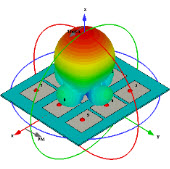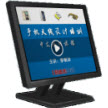wireless charging(移动设备无线充电技术)
12-10
有人做这个吗?
转载一些讨论.
似乎风险投资市场现在搞这个的不少.
Never again carry a charger with you when you travel, where the whole world, whether it's an airport lounge in Tokyo, a coffee shop in New York City or a hotel in Stockholm, uses the same solution. Simply pick up your cell phone, your MP3 player, or your PDA, drop it on a pad, and it'll automatically charge! Just a dream?
Founded in June 2001 by two Cambridge U engineering students, Lily Cheng and James Hay, Splashpower Ltd. is trying to make this dream of every gadget freak come true. Their solution: Wireless power recharging.
The Splashpower technology comprises two parts:
1) the SplashModule power receiver: a sub-millimeter thin receiver module that can be customized to just about any size, shape or curve of a mobile device and makes no visible impact to product appearance.
2) the SplashPad charging base: a thin wireless charging platform the size of a mouse pad that plugs into any electric outlet and can be built into any surface (for instance cars, desks, airplane tables), with in-built protection from over-voltage.
Any device fitted with a SplashModule instantly begins to recharge through magnetic inductive power transfer when placed anywhere on the SplashPad. Multiple devices can be charged simultaneously on a single SplashPad.
People are modding hybrids by making them plug-in hybrids to get more mileage (up to 250 mpg) but automakers have spent millions to advertise that you don't have to plug them in (because of the inconvenience).
Why not add wireless charging (like a sonic care toothbrush) so that you charge it by simply driving into your garage. And eventually the car would wirelessly charge while stopped at signals or even while driving on the highway.
--------------------------------------------------------------------------------
onthefly, Aug 14 2005
Although I'm no expert, I'm guessing inductive charging requires an intimate physical connection between the charger and the object to be charged in order to work. If that's true, your scenarios don't really work.
--------------------------------------------------------------------------------
bristolz, Aug 14 2005
But if it was simply a drive in socket connection, like a cordless drill battery in its dock, at least the garage scenario could be salvaged. Sort of. You might not be able to walk around the front bumper.
--------------------------------------------------------------------------------
oxen crossing, Aug 14 2005
When people say "wireless" these days, they mean some sort of radio signal that allows about 20 feet of separation between two bits of electronic equipment, and only provides for information exchange. The term does not refer to charging, usually.
The Sonic Care toothbrush--to which no link was provided by the author--uses induction charging, which requires that the two bits be in very close contact, as [bristolz] says. Induction charging is a variation of a transformer, and gives the advantage of having no metal-to-metal contacts. But it does require that a plug of some sort goes precisely into a socket of some sort, even if no metal is showing and the socket appears flat.
Induction charging plugs have been used on electric automobiles. They are very slightly easier to use than a metal-to-metal plug, and reduce the chances of electric shock. There are disadvantages, however.
It would be possible to do as [oxen crossing] suggests, and make a drive-in dock, provided the alignment issues could be overcome. For that, an induction charger might be better than a metal-to-metal plug.
As for this idea: it's a wish, and a magical misunderstanding of the technology. [-]
--------------------------------------------------------------------------------
baconbrain, Aug 14 2005
You mean induction charging, as everybody else has observed.
I don't think this is as tricky as people are making out. Already clever wizards have developed charging mats which recharge cameras, phones, etc which are placed haphazardly on them (I read an article on it a few months ago). Okay, so proximity is necessary - so put a big induction mat on the floor of the garage, and make it part of a seesaw arrangement so that the weight of the car's front wheels (say) lifts it off the ground until it mates with a corresponding flat bit on the bottom of the car. Alignment issues would be taken care of by the physical act of getting the car into the garage. Efficiency might not be stellar, so make sure it's powered by solar panels or some such.
Alternatively, fix it so that the act of locking the car doors/putting the handbrake on/ some other 'stationary car' activity drops the charging plate onto the ground. It might even be possible to use the steel reinforcement in the tyres inductively, although that would be trickier. The 'charging at the lights' is not so clever, though - who pays for the power? Where's the incentive to install it? As [baconbrain] points out, there's no feasible way to 'beam' power in the way you first suggested.
--------------------------------------------------------------------------------
moomintroll, Aug 14 2005
转载一些讨论.
似乎风险投资市场现在搞这个的不少.
Never again carry a charger with you when you travel, where the whole world, whether it's an airport lounge in Tokyo, a coffee shop in New York City or a hotel in Stockholm, uses the same solution. Simply pick up your cell phone, your MP3 player, or your PDA, drop it on a pad, and it'll automatically charge! Just a dream?
Founded in June 2001 by two Cambridge U engineering students, Lily Cheng and James Hay, Splashpower Ltd. is trying to make this dream of every gadget freak come true. Their solution: Wireless power recharging.
The Splashpower technology comprises two parts:
1) the SplashModule power receiver: a sub-millimeter thin receiver module that can be customized to just about any size, shape or curve of a mobile device and makes no visible impact to product appearance.
2) the SplashPad charging base: a thin wireless charging platform the size of a mouse pad that plugs into any electric outlet and can be built into any surface (for instance cars, desks, airplane tables), with in-built protection from over-voltage.
Any device fitted with a SplashModule instantly begins to recharge through magnetic inductive power transfer when placed anywhere on the SplashPad. Multiple devices can be charged simultaneously on a single SplashPad.
People are modding hybrids by making them plug-in hybrids to get more mileage (up to 250 mpg) but automakers have spent millions to advertise that you don't have to plug them in (because of the inconvenience).
Why not add wireless charging (like a sonic care toothbrush) so that you charge it by simply driving into your garage. And eventually the car would wirelessly charge while stopped at signals or even while driving on the highway.
--------------------------------------------------------------------------------
onthefly, Aug 14 2005
Although I'm no expert, I'm guessing inductive charging requires an intimate physical connection between the charger and the object to be charged in order to work. If that's true, your scenarios don't really work.
--------------------------------------------------------------------------------
bristolz, Aug 14 2005
But if it was simply a drive in socket connection, like a cordless drill battery in its dock, at least the garage scenario could be salvaged. Sort of. You might not be able to walk around the front bumper.
--------------------------------------------------------------------------------
oxen crossing, Aug 14 2005
When people say "wireless" these days, they mean some sort of radio signal that allows about 20 feet of separation between two bits of electronic equipment, and only provides for information exchange. The term does not refer to charging, usually.
The Sonic Care toothbrush--to which no link was provided by the author--uses induction charging, which requires that the two bits be in very close contact, as [bristolz] says. Induction charging is a variation of a transformer, and gives the advantage of having no metal-to-metal contacts. But it does require that a plug of some sort goes precisely into a socket of some sort, even if no metal is showing and the socket appears flat.
Induction charging plugs have been used on electric automobiles. They are very slightly easier to use than a metal-to-metal plug, and reduce the chances of electric shock. There are disadvantages, however.
It would be possible to do as [oxen crossing] suggests, and make a drive-in dock, provided the alignment issues could be overcome. For that, an induction charger might be better than a metal-to-metal plug.
As for this idea: it's a wish, and a magical misunderstanding of the technology. [-]
--------------------------------------------------------------------------------
baconbrain, Aug 14 2005
You mean induction charging, as everybody else has observed.
I don't think this is as tricky as people are making out. Already clever wizards have developed charging mats which recharge cameras, phones, etc which are placed haphazardly on them (I read an article on it a few months ago). Okay, so proximity is necessary - so put a big induction mat on the floor of the garage, and make it part of a seesaw arrangement so that the weight of the car's front wheels (say) lifts it off the ground until it mates with a corresponding flat bit on the bottom of the car. Alignment issues would be taken care of by the physical act of getting the car into the garage. Efficiency might not be stellar, so make sure it's powered by solar panels or some such.
Alternatively, fix it so that the act of locking the car doors/putting the handbrake on/ some other 'stationary car' activity drops the charging plate onto the ground. It might even be possible to use the steel reinforcement in the tyres inductively, although that would be trickier. The 'charging at the lights' is not so clever, though - who pays for the power? Where's the incentive to install it? As [baconbrain] points out, there's no feasible way to 'beam' power in the way you first suggested.
--------------------------------------------------------------------------------
moomintroll, Aug 14 2005
香港那边儿好象有样机或者产品出来了,不过似乎是给家电充电的。
你有兴趣?:P
射频专业培训教程推荐











